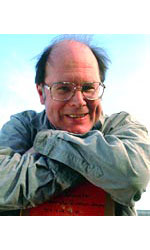
How efficiently can a computer transform physical energy into mathematical work? Can we create a computer that would solve mathematical problems too complex to be solved by all of the computers in the world today even if they number- crunched for millions of years? And how can we send information over a network and be sure no one eavesdrops on our transmission?
In 2002, Dr. Charles H. Bennett, an expert in the physics of information, helped to answer to these questions. Some of the answers involve treating information not as definite thing whose value is independent of the act of observing it -- but rather as a more slippery, shadowy thing which, like an atom or electron, is disturbed by the act of observing it.
Shortly after he came to IBM in 1973, Bennett found a surprising answer to the first question, which had been raised by another IBM physicist, Rolf Landauer. The surprising answer was that computers are not like steam engines. A steam engine, no matter how carefully built, requires a certain amount of fuel to do a given amount of work. But, Bennett found, there is no limit in principle to the amount of mathematical work a computer can do on a given amount of electricity.
Bennett's recent work at IBM has concentrated on a reexamination of the physical basis of information. Since the dawn of the information age fifty years ago, it has been accepted that the physical form of information -- be it a fax, a book, a diskette or a CD-ROM -- is irrelevant to the content of the information itself. For instance, it doesn't make any difference if you have Romeo and Juliet in any of these different forms, it is still Romeo and Juliet. Also, the information is still there even if you can't read it, for instance, if your computer doesn't have a CD-ROM drive.
In recent years, Bennett and other researchers realized that this approach ignores some fundamental laws of nature, called quantum mechanics, which have been well known to physicists for over seventy years. Quantum mechanics allows matter, and the information it carries, to exist in several states at the same time, states that would ordinarily be mutually exclusive, like the bit values of 0 and 1. When information is in an extremely delicate physical form, for instance a single photon of light, any effort to read the information results in a change of the information, because the photon can be in several different states at the same time. For instance, if you have a book of Romeo and Juliet in a quantum state, reading it might turn it into a copy of Hamlet.
The results of this work have been astounding: In collaboration with Professor Gilles Brassard of Univ. de Montreal, and their students, Bennett built a system which allows one person to information to another with the assurance that no one has eavesdropped on it. This is because the information is sent in a delicate quantum form where any observation by a third party would change it and thus alert the receiver. This technique, called quantum cryptography, is currently being developed for military and diplomatic applications where secrecy is essential.
IBM researchers are also investigating the possibility of building quantum computer, one that would process this delicate form of information and thereby be able to solve some problems much faster than an ordinary computer. The amount of speedup depends on the nature of the problem, and in some cases is so extreme that a medium sized quantum computer could outperform all the ordinary computers in the world working together for millions of years. So far, only tiny quantum computers with only a two or three bits of memory have been built. Much research is required to learn how, and whether, the theoretical promise of quantum speedup can be realized.
In 1993 Bennett and collaborators discovered a previously unsuspected fact about quantum information -- that it is possible to exactly "teleport" the quantum state from one particle to another particle, which has never been anywhere near the first particle. These theoretical predictions were confirmed last year by experiments conducted in Innsbruck and Rome, in which photon states were teleported from one end of a laboratory bench to another. Teleportation will probably be used to move information around inside a quantum computer, or from one quantum computer to another when and if we learn how to build these marvelous machines.
Bennett is motivated mainly by an ambition to better understand the universe, and feels lucky to have been involved in finding unsuspected connections between formerly separate fields. He says Quantum information theory reveals the beauty and simplicity of the world."